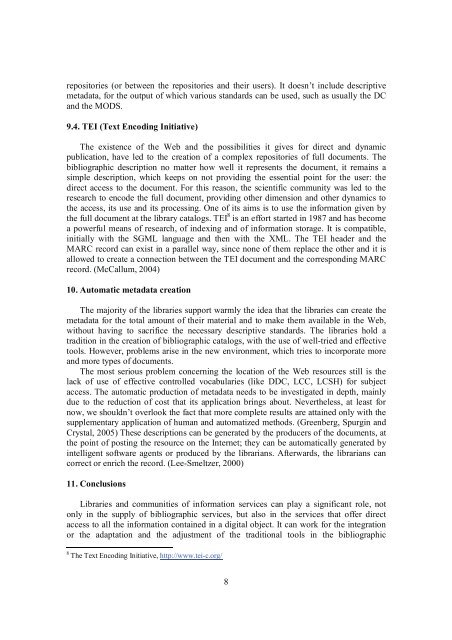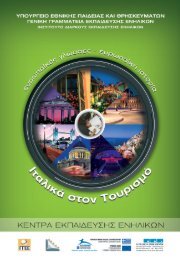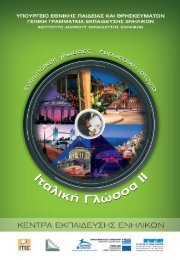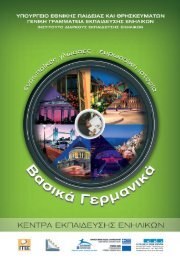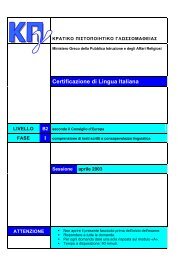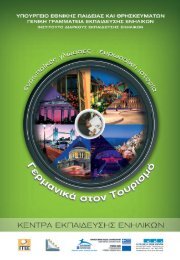Cataloging conventional and digital objects - Digital Library Logo
Cataloging conventional and digital objects - Digital Library Logo
Cataloging conventional and digital objects - Digital Library Logo
You also want an ePaper? Increase the reach of your titles
YUMPU automatically turns print PDFs into web optimized ePapers that Google loves.
epositories (or between the repositories <strong>and</strong> their users). It doesn’t include descriptive<br />
metadata, for the output of which various st<strong>and</strong>ards can be used, such as usually the DC<br />
<strong>and</strong> the MODS.<br />
9.4. TEI (Text Encoding Initiative)<br />
The existence of the Web <strong>and</strong> the possibilities it gives for direct <strong>and</strong> dynamic<br />
publication, have led to the creation of a complex repositories of full documents. The<br />
bibliographic description no matter how well it represents the document, it remains a<br />
simple description, which keeps on not providing the essential point for the user: the<br />
direct access to the document. For this reason, the scientific community was led to the<br />
research to encode the full document, providing other dimension <strong>and</strong> other dynamics to<br />
the access, its use <strong>and</strong> its processing. One of its aims is to use the information given by<br />
the full document at the library catalogs. TEI 8 is an effort started in 1987 <strong>and</strong> has become<br />
a powerful means of research, of indexing <strong>and</strong> of information storage. It is compatible,<br />
initially with the SGML language <strong>and</strong> then with the XML. The TEI header <strong>and</strong> the<br />
MARC record can exist in a parallel way, since none of them replace the other <strong>and</strong> it is<br />
allowed to create a connection between the TEI document <strong>and</strong> the corresponding MARC<br />
record. (McCallum, 2004)<br />
10. Automatic metadata creation<br />
The majority of the libraries support warmly the idea that the libraries can create the<br />
metadata for the total amount of their material <strong>and</strong> to make them available in the Web,<br />
without having to sacrifice the necessary descriptive st<strong>and</strong>ards. The libraries hold a<br />
tradition in the creation of bibliographic catalogs, with the use of well-tried <strong>and</strong> effective<br />
tools. However, problems arise in the new environment, which tries to incorporate more<br />
<strong>and</strong> more types of documents.<br />
The most serious problem concerning the location of the Web resources still is the<br />
lack of use of effective controlled vocabularies (like DDC, LCC, LCSH) for subject<br />
access. The automatic production of metadata needs to be investigated in depth, mainly<br />
due to the reduction of cost that its application brings about. Nevertheless, at least for<br />
now, we shouldn’t overlook the fact that more complete results are attained only with the<br />
supplementary application of human <strong>and</strong> automatized methods. (Greenberg, Spurgin <strong>and</strong><br />
Crystal, 2005) These descriptions can be generated by the producers of the documents, at<br />
the point of posting the resource on the Internet; they can be automatically generated by<br />
intelligent software agents or produced by the librarians. Afterwards, the librarians can<br />
correct or enrich the record. (Lee-Smeltzer, 2000)<br />
11. Conclusions<br />
Libraries <strong>and</strong> communities of information services can play a significant role, not<br />
only in the supply of bibliographic services, but also in the services that offer direct<br />
access to all the information contained in a <strong>digital</strong> object. It can work for the integration<br />
or the adaptation <strong>and</strong> the adjustment of the traditional tools in the bibliographic<br />
8 The Text Encoding Initiative, http://www.tei-c.org/<br />
8


